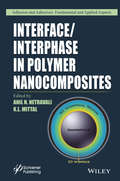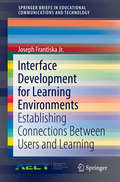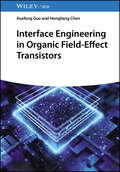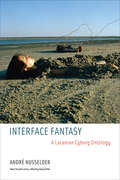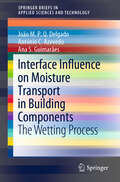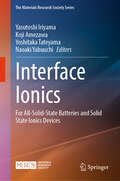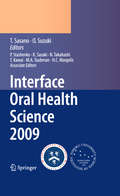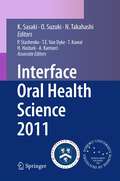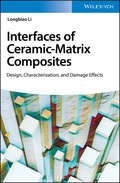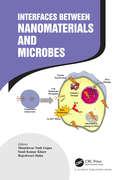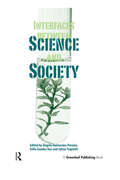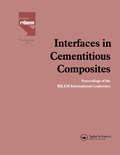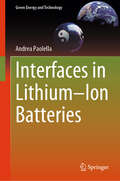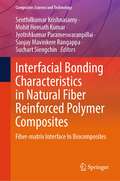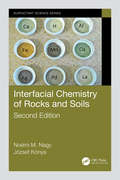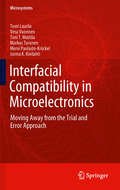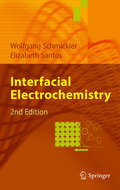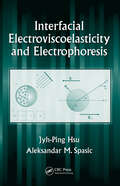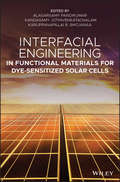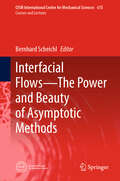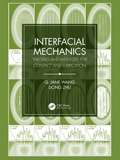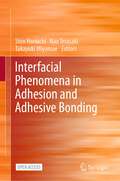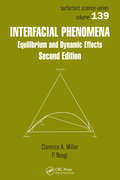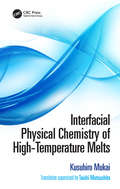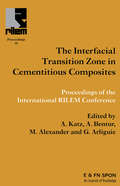- Table View
- List View
Interface / Interphase in Polymer Nanocomposites
by K. L. Mittal Anil N. NetravaliSignificant research has been done in polymeric nanocomposites and progress has been made in understanding nanofiller-polymer interface and interphase and their relation to nanocomposite properties. However, the information is scattered in many different publication media. This is the first book that consolidates the current knowledge on understanding, characterization and tailoring interfacial interactions between nanofillers and polymers by bringing together leading researchers and experts in this field to present their cutting edge research. Eleven chapters authored by senior subject specialists cover topics including: Thermodynamic mechanisms governing nanofiller dispersion, engineering of interphase with nanofillers Role of interphase in governing the mechanical, electrical, thermal and other functional properties of nanocomposites, characterization and modelling of the interphase Effects of crystallization on the interface, chemical and physical techniques for surface modification of nanocellulose reinforcements Electro-micromechanical and nanoindentation techniques for interface evaluation, molecular dynamics (MD) simulations to quantify filler-matrix adhesion and nanocomposite mechanical properties.
Interface Development for Learning Environments: Establishing Connections Between Users and Learning (SpringerBriefs in Educational Communications and Technology)
by Joseph Frantiska Jr.This brief will examine and explore some tools and techniques that can be used to develop interfaces for learning environments. Interface design has been a topic in software engineering for many years. The advent of graphical user interfaces has created many remedies and challenges for the software engineer. In recent years with an increased emphasis in educational technology, instructional designers are also included in this arena. The interface can be a driver in terms of a learning environment’s ability to engage a student. It can also provide a point of information exchange and therefore learning between the student and the environment’s software. Thus, the issue of an interface is vital to the success of a learning environment. This brief will produce a variety of interfaces for various environments to allow the designer to contrast and compare them based upon the required purpose. The designer will have a toolkit filled with tools and techniques which will allow for interfaces that will engage the student and facilitate their learning. The primary audiences are K-12 and post-secondary educators who desire to create digital media based educational materials.
Interface Engineering in Organic Field-Effect Transistors
by Xuefeng Guo Hongliang ChenInterface Engineering in Organic Field-Effect Transistors Systematic summary of advances in developing effective methodologies of interface engineering in organic field-effect transistors, from models to experimental techniques Interface Engineering in Organic Field-Effect Transistors covers the state of the art in organic field-effect transistors and reviews charge transport at the interfaces, device design concepts, and device fabrication processes, and gives an outlook on the development of future optoelectronic devices. This book starts with an overview of the commonly adopted methods to obtain various semiconductor/semiconductor interfaces and charge transport mechanisms at these heterogeneous interfaces. Then, it covers the modification at the semiconductor/electrode interfaces, through which to tune the work function of electrodes as well as reveal charge injection mechanisms at the interfaces. Charge transport physics at the semiconductor/dielectric interface is discussed in detail. The book describes the remarkable effect of SAM modification on the semiconductor film morphology and thus the electrical performance. In particular, valuable analyses of charge trapping/detrapping engineering at the interface to realize new functions are summarized. Finally, the sensing mechanisms that occur at the semiconductor/environment interfaces of OFETs and the unique detection methods capable of interfacing organic electronics with biology are discussed. Specific sample topics covered in Interface Engineering in Organic Field-Effect Transistors include: Noncovalent modification methods, charge insertion layer at the electrode surface, dielectric surface passivation methods, and covalent modification methods Charge transport mechanism in bulk semiconductors, influence of additives on materials’ nucleation and morphology, solvent additives, and nucleation agents Nanoconfinement effect, enhancing the performance through semiconductor heterojunctions, planar bilayer heterostructure, ambipolar charge-transfer complex, and supramolecular arrangement of heterojunctions Dielectric effect in OFETs, dielectric modification to tune semiconductor morphology, surface energy control, microstructure design, solution shearing, eliminating interfacial traps, and SAM/SiO2 dielectrics A timely resource providing the latest developments in the field and emphasizing new insights for building reliable organic electronic devices, Interface Engineering in Organic Field-Effect Transistors is essential for researchers, scientists, and other interface-related professionals in the fields of organic electronics, nanoelectronics, surface science, solar cells, and sensors.
Interface Fantasy: A Lacanian Cyborg Ontology (Short Circuits)
by Andre NusselderBehind our computer screens we are all cyborgs: through fantasy we can understand our involvement in virtual worlds.Cyberspace is first and foremost a mental space. Therefore we need to take a psychological approach to understand our experiences in it. In Interface Fantasy, André Nusselder uses the core psychoanalytic notion of fantasy to examine our relationship to computers and digital technology. Lacanian psychoanalysis considers fantasy to be an indispensable “screen” for our interaction with the outside world; Nusselder argues that, at the mental level, computer screens and other human-computer interfaces incorporate this function of fantasy: they mediate the real and the virtual. Interface Fantasy illuminates our attachment to new media: why we love our devices; why we are fascinated by the images on their screens; and how it is possible that virtual images can provide physical pleasure. Nusselder puts such phenomena as avatars, role playing, cybersex, computer psychotherapy, and Internet addiction in the context of established psychoanalytic theory. The virtual identities we assume in virtual worlds, exemplified best by avatars consisting of both realistic and symbolic self-representations, illustrate the three orders that Lacan uses to analyze human reality: the imaginary, the symbolic, and the real. Nusselder analyzes our most intimate involvement with information technology—the almost invisible, affective aspects of technology that have the greatest impact on our lives. Interface Fantasy lays the foundation for a new way of thinking that acknowledges the pivotal role of the screen in the current world of information. And it gives an intelligible overview of basic Lacanian principles (including fantasy, language, the virtual, the real, embodiment, and enjoyment) that shows their enormous relevance for understanding the current state of media technology.
Interface Influence on Moisture Transport in Building Components: The Wetting Process (SpringerBriefs in Applied Sciences and Technology)
by Ana S. Guimarães António C. Azevedo João M. DelgadoThe knowledge of moisture migration inside building materials and construction building components is decisive for the way they behave when in use. The durability, waterproofing, degrading aspect and thermal behaviour of these materials are strongly influenced by the existence of moisture within their interior, which provoke changes in their normal performance, something that is normally hard to predict. Due to the awareness of this problem, the scientific community have per-formed various studies about the existence of moisture inside porous materials. The complex aspects of moisture migration phenomenon tended to encompass monolithic building elements, since the existence of joints or layers contributes to the change of moisture transfer along the respective building element that contribute to the change of mass transfer law. The presentation of an experimental analyses concerning moisture transfer in the interface of material that makes up masonry is described in such a way as to evaluate the durability and/or avoid building damages. In this work it was analysed, during the wetting process, the influence of different types of interface, commonly observed in masonry, such as: perfect con-tact, joints of cement mortar, lime mortar, and the air space interface. The results allow the calculation of the hygric resistance. With these results, it is possible to use any advanced hygrothermal simulation program to study the water transport in building elements, considering different interfaces and their hygric resistance.
Interface Ionics: For All-Solid-State Batteries and Solid State Ionics Devices (The Materials Research Society Series)
by Yasutoshi Iriyama Koji Amezawa Yoshitaka Tateyama Naoaki YabuuchiThis book focuses on ion transport and storage around the interfaces in solid-state-ionics devices, especially for all-solid-state batteries. It covers materials research from fundamental model systems to practically important materials, advanced analysis methods, and computational & data science. This volume is intended for researchers in academia and industry who have studied or worked in this field. It is expected to provide readers with guidelines for interface and material design aimed at advancing all-solid-state batteries, as well as insights into the development of novel solid-state ionics devices. This book is a summary of the studies obtained in the Grant-in-Aid for Scientific Research on Innovative Areas "Interface Ionics” founded by the Japanese Ministry of Education, Culture, Sports, Science and Technology (MEXT) during 2019-2023.
Interface Oral Health Science 2009
by Martin A. Taubman Toshihisa Kawai Osamu Suzuki Henry C. Margolis Nobuhiro Takahashi Keiichi Sasaki Takashi Sasano Philip StashenkoThe Tohoku University Graduate School of Dentistry has proposed Interface Oral Health Science as the main theme of next-generation dental research since 2002. That theme is based on the new concept that healthy oral function is provided by biological and biomechanical harmony among three systems: oral tissues, parasites, and biomaterials, and that oral diseases are interpreted as "interface diseases" caused by disruption of the intact interfaces among those systems.
Interface Oral Health Science 2011
by Keiichi SasakiInterface oral health science was founded on the concept that healthy oral function is maintained by biological and biomechanical harmony between three systems: oral tissues, parasitic oral microorganisms, and biomaterials. On that basis, dental caries, periodontal disease, and temporomandibular joint disorders may be regarded as interface disorders that result from a disruption in the intact interface of these systems. Interface oral health science encompasses the fields of dentistry and dental medicine, but also extends to general medicine, agriculture, biomaterials science, bioengineering, and pharmacology. This book is a compendium of the research presented at symposiums held in 2011 by the Tohoku University Graduate School of Dentistry and by the Forsyth Institute. Its publication is intended provide further impetus for the progress of oral science and health, pointing the way for dental research for future generations.
Interface of Ceramic-Matrix Composites: Design, Characterization, and Damage Effects
by Longbiao LiThe book "Interfaces of Ceramic-Matrix Composites" demonstrates the definition, function and type of the interface of ceramic-matrix composites and gives comprehensive investigations on the interface design, interface characterization, interface assessment, and interface damage law of both C/SiC and SiC/SiC ceramic-matrix composites subjected to tensile and fatigue loading at different testing conditions. Thereby, it helps material designers and engineers to better design ceramic-matrix composite components for applications.
Interfaces Between Nanomaterials and Microbes
by Munishwar Nath Gupta; Sunil Kumar Khare; Rajeshwari SinhaNanomaterials are becoming ubiquitous; microbes similarly are everywhere. This book focuses on various ways the diverse nanomaterials interact with microbial communities and implications of such interactions. Both toxicity and beneficial effects of nanomaterial-microbe interactions have been covered. This includes areas such as fate and bioavailability of nanomaterials in environments, microbial synthesis of nanomaterials and antimicrobial action of nanomaterials. Fairly comprehensive but with narrow focus, the book provides useful insights into these interactions which need to be factored in while designing nanoscience based new technologies.
Interfaces between Science and Society
by Ângela Guimarães Pereira Sofia Guedes Vaz Sylvia TognettiThe project of science has been to provide answers to questions about the world and how it works. Often, this lofty role has been characterised by a narrow and dogmatic scientific training, an unwillingness to communicate to differing stakeholder needs, a refusal to accept and to manage uncertainty, complexity and value commitments, and the reduction of knowledge assessment to colleague peer review on narrowly technical issues. Times have changed. As the world faces increasingly disparate challenges, science is subjected to increasingly vehement demands from a society calling for transparency, openness and public participation in science policy. Science is going through an evolutionary process. Perhaps the most painful process it has ever encountered. Research on the interfaces between science and society is a burgeoning area. A new conception of knowledge now appears to be emerging, based on the awareness of complexity, uncertainty and a plurality of legitimate perspectives and interests. Democracy is extending into the previously quite exclusive scientific realm, and science must now submit to public scrutiny and participation in the governance of knowledge. This book provides much-needed reflections on the methods and tools for knowledge quality assurance, particularly on its inputs to extended policy and decision-making processes. The overall aim is to improve the relationship between science and society. The discussion involves six themes: communicating between plural perspectives; accepting and learning how to manage uncertainty, complexity and value commitments; acknowledging new conceptions of knowledge; implementing transparency, openness and participation in science policy; valuing community-based research; and exploring how new ICT can support inclusive governance. Taken together, these themes provide both a framework and vision on how to conceive, discuss and evaluate the changes that are occurring. The chapters cover theory, practice, approaches, experiences, ideas and suggestions for a move beyond "talking the talk" to "walking the walk". Science and policy interfaces are dynamic processes needing to permanently redefine themselves and their roles. This book contributes to the enrichment and deepening of our understanding of these important new trends in the social relations of science, which are fundamental to our understanding of the prospects for further progress. The book will be essential reading for scientists, policy-makers, managers and the public.
Interfaces in Cementitious Composites
by J.C. MasoThis book presents a series of high level contributions from leading research groups around the world in the field of cement and concrete science. It deals with the rapidly advancing subject of the interfaces between the components of cementitious materials: cements, aggregates, fibres, reinforcement. It will be valuable for all those involved with
Interfaces in Lithium–Ion Batteries (Green Energy and Technology)
by Andrea PaolellaThis book explores the critical role of interfaces in lithium-ion batteries, focusing on the challenges and solutions for enhancing battery performance and safety. It sheds light on the formation and impact of interfaces between electrolytes and electrodes, revealing how side reactions can diminish battery capacity. The book examines the nanochemistry of these reactions, emphasizing their profound influence on overall battery properties. It highlights the urgent need for battery material scientists to develop new additives and chemistries to address these interface-related issues, which have significant industrial implications. After providing a fundamental understanding of Li-ion batteries, the book analyzes the evolution of the solid electrolyte interface (SEI) by considering various negative electrode materials such as graphite, silicon, lithium metal, and anode-less configurations. It also explores the chemistries of cathode materials, including their decomposition and methods to mitigate unwanted oxidation. Furthermore, the book discusses the growing interest in solid-state batteries as a future technology, focusing on the reactivity of polymeric and ceramic solid electrolytes with anodes and cathodes, which presents additional challenges at the interface level. Finally, it addresses the specific challenges associated with emerging chemistries like Li-S and Li-air batteries, providing insights into polysulfide formation and LiOH conversion.
Interfacial Bonding Characteristics in Natural Fiber Reinforced Polymer Composites: Fiber-matrix Interface In Biocomposites (Composites Science and Technology)
by Jyotishkumar Parameswaranpillai Suchart Siengchin Sanjay Mavinkere Rangappa Senthilkumar Krishnasamy Mohit Hemath KumarThis book provides a general overview of the importance of fibre-matrix interfacial bonding characteristics in natural fibre-based composites to obtain optimal material properties for a specific application. Composites materials are prepared by combining fibres and polymers to achieve superior materials properties than those of the individual components. Composite materials are used to produce lightweight components with increased stiffness and strength; their properties can also be tailored for any specific applications. The glass fibre reinforced composites dominate 95% of the thermoplastic and thermoset-based composites. However, the natural fibre reinforced composites can give competition to the glass fibres due to their advantages such as biodegradability, low density, low cost, and good mechanical properties. This book looks into biocomposites and its important aspect of optimization of materials’ performance by fine-tuning the fibre-matrix bonding characteristics. The chapters in the book look at different plant fibres such as kenaf, pineapple leaf, jute, date palm, luffa, cotton, hemp, wood, bamboo, flax, and straw and the different approaches to enhance the fibre-matrix interfacial bonding through physical and/or chemical treatment methods. It demonstrates that the nature of fibre-matrix bonding has a significant effect on the properties such as tensile, flexural, impact, inter-laminar shear strength, moisture absorption, thickness swelling, thermal, chemical, damping, creep, and fatigue. Its content appeals to academics, students, researcher, and scientist who are working in the field to produce biodegradable and recyclable materials in the composite industry.
Interfacial Chemistry of Rocks and Soils (Surfactant Science #148)
by Noémi M. Nagy József KónyaKnowledge of the basic interactions that take place between geological materials and different substances is the first step in understanding the effects of adsorption and other interfacial processes on the quality of rocks and soils, and on driving these processes towards a beneficial or neutral result. Interfacial Chemistry of Rocks and Soils examines the different processes at solid and liquid interfaces of soil and rock, presenting a complete analysis that emphasizes the importance of chemical species on these interactions. This Second Edition features novel results in the field and expanded coverage of the kinetics of interfacial processes. New content includes models of heterogeneous isotope exchange, sorption isotherms for heterovalent cation exchange, as well as sorption of anions by chemically modified clays. Summarizing the results and knowledge of the authors’ research in this field over several decades, this volume: Explores the individual components of the studied systems: the solid, the solution, and the interface Discusses the characteristics and thermodynamics of the interface Profiles the most important analytical methods in the study of interfacial processes Demonstrates transformations initiated by interfacial processes Outlines avenues of treatment that may solve geological, soil science, and environmental problems Drawn chiefly from the authors’ years of research at the Imre Lajos Isotope Laboratory in the Department of Physical Chemistry at the University of Debrecen in Hungary, this book discusses chemical reactions on the surfaces/interfaces of soils and rocks; examines the role of these processes in environmental, colloid and geochemistry; and explores the effects on agricultural, environmental and industrial applications.
Interfacial Compatibility in Microelectronics
by Markus Turunen Toni T. Mattila Tomi Laurila Jorma Kivilahti Vesa Vuorinen Mervi Paulasto-KröckelInterfaces between dissimilar materials are met everywhere in microelectronics and microsystems. In order to ensure faultless operation of these highly sophisticated structures, it is mandatory to have fundamental understanding of materials and their interactions in the system. In this difficult task, the "traditional" method of trial and error is not feasible anymore; it takes too much time and repeated efforts. In Interfacial Compatibility in Microelectronics, an alternative approach is introduced. In this revised method four fundamental disciplines are combined: i) thermodynamics of materials ii) reaction kinetics iii) theory of microstructures and iv) stress and strain analysis. The advantages of the method are illustrated in Interfacial Compatibility in Microelectronics which includes: solutions to several common reliability issues in microsystem technology, methods to understand and predict failure mechanisms at interfaces between dissimilar materials and an approach to DFR based on deep understanding in materials science, rather than on the use of mechanistic tools, such as FMEA. Interfacial Compatibility in Microelectronics provides a clear and methodical resource for graduates and postgraduates alike.
Interfacial Electrochemistry
by Wolfgang Schmickler Elizabeth SantosElectrochemistry is an old branch of physical chemistry. Due to the development of surface sensitive techniques, and a technological interest in fuel cells and batteries, it has recently undergone a rapid development. This textbook treats the field from a modern, atomistic point of view while integrating the older, macroscopic concepts. The increasing role of theory is reflected in the presentation of the basic ideas in a way that should appeal to experimentalists and theorists alike. Special care is taken to make the subject comprehensible to scientists from neighboring disciplines, especially from surface science. The book is suitable for an advanced course at the master or Ph.D. level, but should also be useful for practicing electrochemists, as well as to any scientist who wants to understand modern electrochemistry.
Interfacial Electroviscoelasticity and Electrophoresis
by Jyh-Ping Hsu Aleksandar M. SpasicIn the 20 years since the pilot plant experiments used to develop the concept of electroviscoelasticity, inroads have been made in the understanding of its many related processes. Interfacial Electroviscoelasticity and Electrophoresis meets a massive scientific challenge by presenting deeper research and developments in the basic and applied scienc
Interfacial Engineering in Functional Materials for Dye-Sensitized Solar Cells
by Alagarsamy PandikumarOffers an Interdisciplinary approach to the engineering of functional materials for efficient solar cell technology Written by a collection of experts in the field of solar cell technology, this book focuses on the engineering of a variety of functional materials for improving photoanode efficiency of dye-sensitized solar cells (DSSC). The first two chapters describe operation principles of DSSC, charge transfer dynamics, as well as challenges and solutions for improving DSSCs. The remaining chapters focus on interfacial engineering of functional materials at the photoanode surface to create greater output efficiency. Interfacial Engineering in Functional Materials for Dye-Sensitized Solar Cells begins by introducing readers to the history, configuration, components, and working principles of DSSC It then goes on to cover both nanoarchitectures and light scattering materials as photoanode. Function of compact (blocking) layer in the photoanode and of TiCl4 post-treatment in the photoanode are examined at next. Next two chapters look at photoanode function of doped semiconductors and binary semiconductor metal oxides. Other chapters consider nanocomposites, namely, plasmonic nanocomposites, carbon nanotube based nanocomposites, graphene based nanocomposites, and graphite carbon nitride based nanocompositesas photoanodes. The book: Provides comprehensive coverage of the fundamentals through the applications of DSSC Encompasses topics on various functional materials for DSSC technology Focuses on the novel design and application of materials in DSSC, to develop more efficient renewable energy sources Is useful for material scientists, engineers, physicists, and chemists interested in functional materials for the design of efficient solar cells Interfacial Engineering in Functional Materials for Dye-Sensitized Solar Cells will be of great benefit to graduate students, researchers and engineers, who work in the multi-disciplinary areas of material science, engineering, physics, and chemistry.
Interfacial Flows—The Power and Beauty of Asymptotic Methods (CISM International Centre for Mechanical Sciences #615)
by Bernhard ScheichlThis book presents the state of the art of asymptotic and related mathematical methods, and how to apply them, as the means of choice, to representative building blocks of interfacial-flow phenomena. After an introduction which exemplifies the application of perturbation techniques in describing the well-known teapot effect, chapter 2 covers the status quo of the theory of inviscid sloshing and the associated modal analysis of free-surface waves; and chapter 3 envisages the intersection between dimensional analysis, scaling laws and the reduction of the governing partial differential equations to ordinary ones. The other chapters focus on, respectively, the singularity formation in free surfaces as a self-similar phenomenon in thin-film dynamics, the elastohydrodynamic lubrication by weakly viscoelastic fluids, and the inertia-free film flows under gravity with contact lines. It addresses graduate students and early-career researchers interested in theoretical fluid mechanics and its mathematical foundations, but also experienced scientists, actively employing perturbation analysis for long, who want to broaden their horizon.
Interfacial Mechanics: Theories and Methods for Contact and Lubrication
by Jane WangUnderstanding the characteristics of material contact and lubrication at tribological interfaces is of great importance to engineering researchers and machine designers. Traditionally, contact and lubrication are separately studied due to technical difficulties, although they often coexist in reality and they are actually on the same physical ground. Fast research advancements in recent years have enabled the development and application of unified models and numerical approaches to simulate contact and lubrication, merging their studies into the domain of Interfacial Mechanics. This book provides updated information based on recent research progresses in related areas, which includes new concepts, theories, methods, and results for contact and lubrication problems involving elastic or inelastic materials, homogeneous or inhomogeneous contacting bodies, using stochastic or deterministic models for dealing with rough surfaces. It also contains unified models and numerical methods for mixed lubrication studies, analyses of interfacial frictional and thermal behaviors, as well as theories for studying the effects of multiple fields on interfacial characteristics. The book intends to reflect the recent trends of research by focusing on numerical simulation and problem solving techniques for practical interfaces of engineered surfaces and materials. This book is written primarily for graduate and senior undergraduate students, engineers, and researchers in the fields of tribology, lubrication, surface engineering, materials science and engineering, and mechanical engineering.
Interfacial Phenomena in Adhesion and Adhesive Bonding
by Shin Horiuchi Nao Terasaki Takayuki MiyamaeThis open access book reviews the recent research achievements of the investigation of interfacial phenomena in polymer/polymer and polymer/metal joint interfaces with the state-of-the-art analytical techniques not previously used in the field of adhesion and bonding. Adhesion performance is determined not only by the two-dimensional interfaces but also by a three-dimensional (3D) region having different properties and structural characteristics that extends into the bulk materials. In this book, the authors also discuss in detail the bonding mechanism by characterizing such 3D regions called “interphase”. The book is of great interest to researchers and engineers devoted to adhesion science and technology. Videos via app: download the SN More Media app for free, scan an image or a link with play button, and access videos directly on your smartphone or tablet.
Interfacial Phenomena: Equilibrium and Dynamic Effects, Second Edition
by Clarence A. Miller P. NeogiSince the publication of the first edition of Interfacial Phenomena, the interest in interfaces and surfactants has multiplied, along with their applications. Experimental and theoretical advances have provided scientists with greater insight into the structure, properties, and behavior of surfactant and colloid systems.Emphasizing equil
Interfacial Physical Chemistry of High-Temperature Melts
by Taishi Matsushita Kusuhiro MukaiThis English translation of a well-known Japanese book covers interfacial physicochemistry in materials science, especially for iron- and steelmaking processes. Interfacial Physical Chemistry of High-Temperature Melts bridges the gap between the basics and applications of physicochemistry. The book begins with an overview of the fundamentals of interfacial physical chemistry and discusses surface tension, describing the derivation of important equations to guide readers to a deep understanding of the phenomenon. The book then goes on to introduce interfacial properties of high-temperature melts, especially the Marangoni effect, and discusses applications to materials processing at high temperature focusing on recent research results by the author and the co-workers. This book is aimed at researchers, graduate students, and professionals in materials processing. Video clips of in-situ observation including experiments under microgravity condition and x-ray observation are available for download on the publisher's website to allow for a deeper understanding.
Interfacial Transition Zone in Cementitious Composites
by M. Alexander A. Katz, A. Bentur G. ArliguieThis book addresses the need to resolve the ITZ's influence on engineering and durability characteristics of cementious composites, identifies the systems and properties that are affected by it, and quantifies these effects in order to prepare the base for engineering design tools. This volume presents the proceedings of the Second International RI
